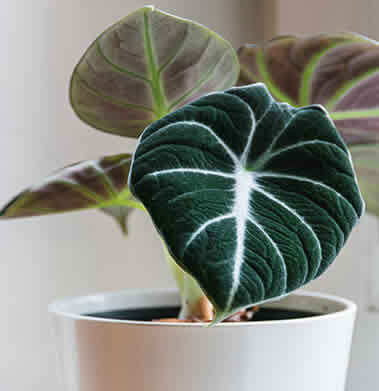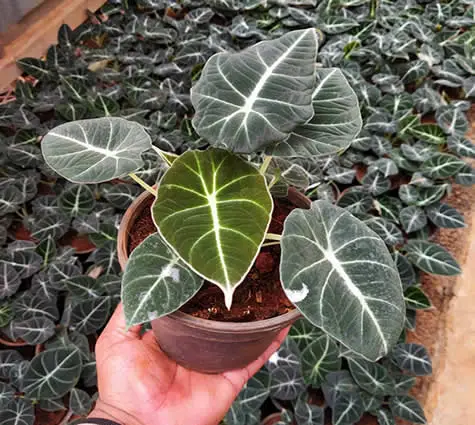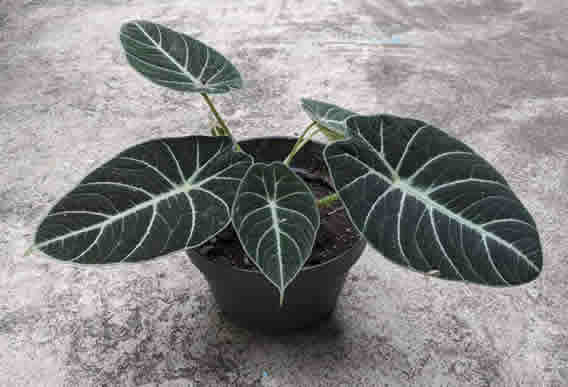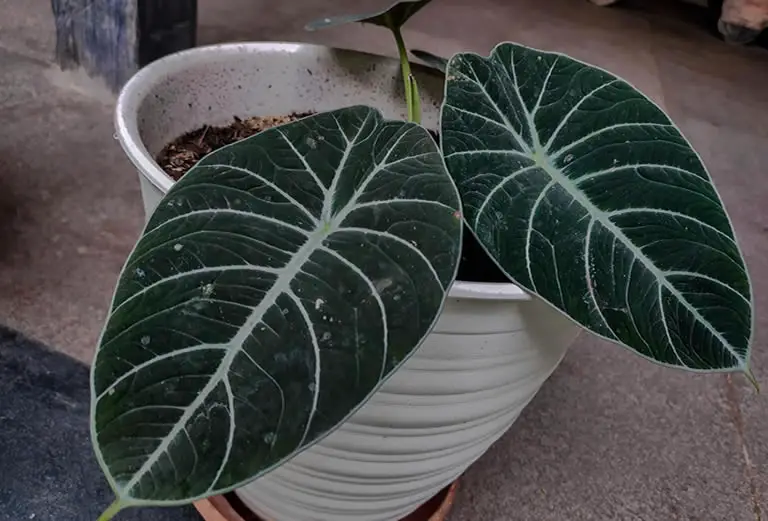Alocasia Black Velvet (Alocasia reginula) is a compact, velvety-leaved beauty that adds an elegant, moody vibe to any indoor plant collection.
With its dark, heart-shaped foliage and silvery veins, it’s a plant lover’s dream—but it does best with a bit of special care.
Here’s everything you need to know to keep your Alocasia Black Velvet happy and healthy.
Table of Contents
- Getting to Know Alocasia Black Velvet
- Light Needs: Keep It Bright, But Indirect
- Watering: Moist, Not Soggy
- Soil: Airy and Well-Draining Is Key
- Temperature: Tropical Warmth, Please
- Humidity: The More the Merrier
- Fertilizer: Go Lightly During Growth
- Repotting: Infrequent and Gentle
- Pruning and Cleaning: Keep It Tidy
- Propagation: Easy with Offsets or Division
- Common Issues and How to Fix Them
- Toxicity Warning
- Final Thoughts
Getting to Know Alocasia Black Velvet
Native to the tropical forests of Borneo, this petite Alocasia variety is known for its stunning contrast: deep green, almost black leaves paired with shimmering pale veins.

Its thick, suede-like foliage and rhizomatous root system make it a unique and eye-catching houseplant.
Reaching only about 18 inches tall and wide, it’s perfect for smaller spaces or terrariums.
Light Needs: Keep It Bright, But Indirect
Alocasia Black Velvet isn’t a sunbather. It thrives in bright, indirect light but is more tolerant of lower light than some other Alocasias.
Direct sun can bleach or scorch the velvety leaves, while too little light may cause legginess or slow growth.
A spot near an east- or north-facing window, or filtered light from a south-facing one, usually works well.
Watering: Moist, Not Soggy
This plant likes to stay just lightly moist, but it’s sensitive to overwatering.
Let the top 2 inches of soil dry out before watering again.
During active growth in warmer months, water thoroughly and let excess drain away.
In winter or dormancy, cut back on watering and let the plant rest.
Always use filtered or dechlorinated water when possible.
Soil: Airy and Well-Draining Is Key
To prevent root rot, use a chunky, free-draining soil mix.
A good formula is 2 parts perlite, 2 parts orchid bark, and 1 part potting soil.

You can also add a bit of coco coir or worm castings for extra organic matter. Avoid dense or moisture-retentive soils.
Temperature: Tropical Warmth, Please
Black Velvet Alocasias thrive in temperatures between 59°F (15°C) and 80°F (27°C).
Avoid letting temps dip below 55°F (13°C).
Keep it away from cold drafts or heat vents, which can cause leaf damage or stress.
Humidity: The More the Merrier
Humidity is a must—ideally 60–75%. Anything under 40% and you may start seeing crispy leaf edges.
Grouping your tropical plants, using a pebble tray, or investing in a humidifier will help maintain the right level.
Especially in winter, monitor indoor humidity carefully.
Fertilizer: Go Lightly During Growth
Alocasia Black Velvet is a light feeder.
During the growing season, feed monthly with a balanced, water-soluble fertilizer at half strength.
Avoid fertilizing in the dormant season. Always fertilize after watering to protect the roots.
Repotting: Infrequent and Gentle
This plant likes to be slightly rootbound.
Repot only every 2–3 years, or when roots are visibly circling the pot.

Choose a pot just one size up and repot in spring when the plant is actively growing. Be gentle with its sensitive roots.
Pruning and Cleaning: Keep It Tidy
Minimal pruning is needed—just remove any yellowing or damaged leaves using clean, sharp shears.
The velvety leaves can collect dust, so wipe them occasionally with a damp cloth (no misting—it can cause spotting).
Propagation: Easy with Offsets or Division
Black Velvet Alocasias produce offsets that can be separated and potted individually.
You can also divide the rhizome.
Always propagate during the growing season and ensure each division has roots.
Common Issues and How to Fix Them
- Yellow leaves: Often due to overwatering or poor drainage.
- Brown tips: Usually caused by low humidity or dry soil.
- Drooping: May be from underwatering, overwatering, or a sudden temperature change.
- Pests: Spider mites are the most common offenders. Treat with insecticidal soap and improve humidity.
Toxicity Warning
Like most Alocasias, Black Velvet contains calcium oxalate crystals, which are toxic to pets and humans if ingested.
It can also cause skin irritation, so handle with care.
Final Thoughts
Alocasia Black Velvet might seem a bit fussy at first, but once you learn its preferences, it becomes an easy and rewarding plant to grow.
Give it bright light, the right humidity, and a well-draining mix—and you’ll be rewarded with that stunning, velvety foliage all year round.
Related Articles
You may be interested in these other articles about Alocasia care:
Alocasia Plant Care: Indoor & Outdoor Care Guide
Alocasia Water Guide. Watering Alocasia & Growing Alocasia In Water
Understanding Alocasia Dormancy: What It Is, Why It Happens, and How to Handle It
Alocasia Dragon Scale Care Guide: How to Keep This Jewel Alocasia Thriving
Why Are My Alocasia Leaves Turning Yellow? Causes, Fixes, and What to Do Next
Why Is My Alocasia Drooping? Common Causes and How to Revive It
How to Keep Your Alocasia Wentii Thriving: Complete Care Guide
Alocasia Frydek Care Guide: How to Keep Your Green Velvet Thriving
Caring for Alocasia Zebrina: Tips for Thriving Stripes

